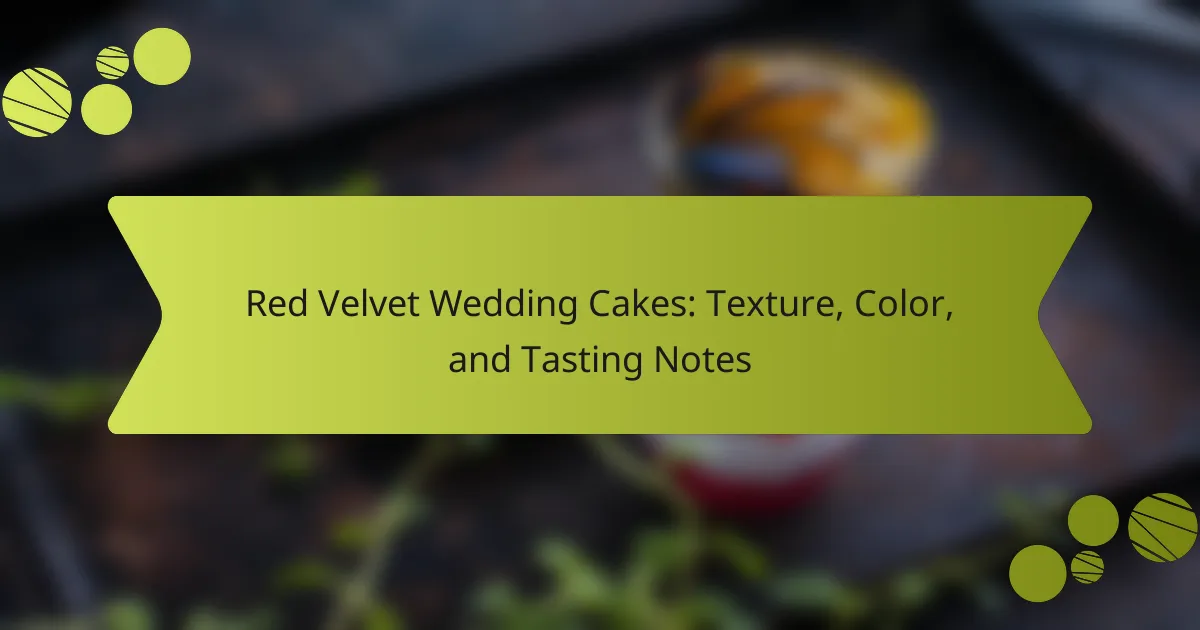Red velvet wedding cakes are characterized by their distinctive red color, moist texture, and rich flavor, making them a popular choice for weddings. This cake features a tender crumb achieved through buttermilk and vegetable oil, often layered with cream cheese or buttercream frosting. The unique color results from a chemical reaction between cocoa powder and acidic ingredients like buttermilk and vinegar. The article explores the cake’s texture, color combinations, and flavor profile, highlighting its luxurious mouthfeel and the balance of sweetness from the frosting.
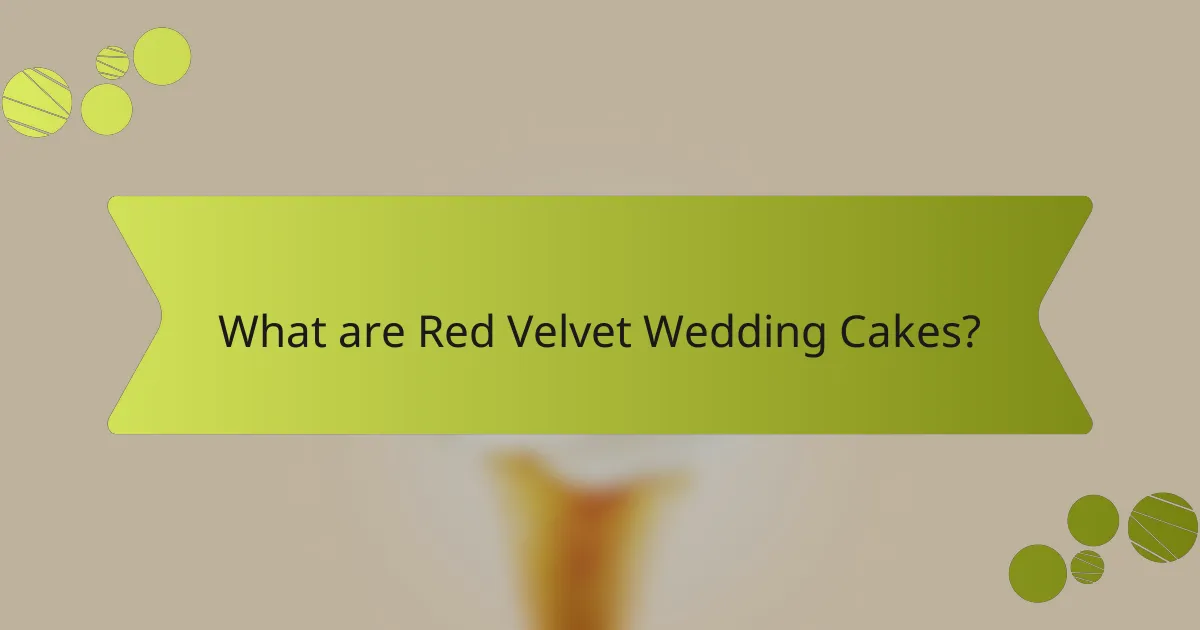
What are Red Velvet Wedding Cakes?
Red velvet wedding cakes are a type of cake known for their distinctive red color and rich flavor. They typically feature a moist, tender crumb due to the use of buttermilk and vegetable oil. The cake is often layered with cream cheese or buttercream frosting, enhancing its sweetness and texture. Red velvet cakes originated in the 19th century and gained popularity in the southern United States. The unique color comes from a reaction between cocoa powder and acidic ingredients like buttermilk and vinegar. This cake is often chosen for weddings due to its striking appearance and delicious taste.
How did Red Velvet Cake become popular for weddings?
Red Velvet Cake became popular for weddings due to its striking appearance and unique flavor. The cake’s vibrant red color symbolizes love and passion, making it a fitting choice for wedding celebrations. Originally, it gained attention in the 1920s and 1930s, particularly in the Southern United States. Its association with luxury and elegance was reinforced by its inclusion in high-profile events and cookbooks. The cake’s rich texture, complemented by cream cheese frosting, appeals to many couples. Additionally, its distinct flavor profile sets it apart from traditional wedding cakes. Over time, social media and food blogs further fueled its popularity, showcasing visually appealing wedding desserts. As a result, Red Velvet Cake has become a modern classic for weddings.
What historical significance does Red Velvet Cake hold?
Red Velvet Cake holds historical significance as a popular dessert originating in the early 20th century. It gained prominence in the 1920s, particularly in the southern United States. The cake’s distinctive red color was initially achieved with cocoa powder reacting with acidic ingredients. This unique appearance contributed to its popularity in celebrations and special occasions. The recipe became widely known after being featured in a 1920s advertisement for the Adams Extract Company. The cake’s association with luxury and indulgence has made it a staple at weddings and other formal events.
How has the recipe evolved over time?
The recipe for red velvet wedding cakes has evolved significantly over time. Initially, red velvet cakes were made with cocoa powder and a small amount of red food coloring. This combination created a subtle chocolate flavor and a slight reddish hue. In the 1920s, the introduction of buttermilk and vinegar enhanced the cake’s moisture and tenderness.
By the 1940s, the cake gained popularity due to its vibrant color, often attributed to the reaction between cocoa powder and acidic ingredients. The modern version typically includes cream cheese frosting, which balances the cake’s sweetness. Additionally, various adaptations now incorporate different flavor profiles, such as vanilla or almond extracts.
Today, red velvet cakes are often made with bright red food coloring to achieve a more vivid appearance. This evolution reflects changing tastes and baking techniques over the decades. The red velvet cake has transitioned from a simple dessert to a popular choice for weddings, showcasing its enduring appeal.
What are the key characteristics of Red Velvet Wedding Cakes?
Red Velvet Wedding Cakes are characterized by their distinct red color, velvety texture, and subtle chocolate flavor. The vibrant red hue comes from cocoa powder and red food coloring. This cake typically has a moist crumb due to the use of buttermilk or yogurt. Cream cheese frosting is a common pairing, enhancing the flavor profile. The cake’s texture is soft and tender, making it appealing for weddings. Additionally, the unique combination of flavors and colors creates a visually striking centerpiece. These characteristics make Red Velvet Wedding Cakes a popular choice for celebrations.
What texture should a Red Velvet Cake have?
A Red Velvet Cake should have a soft, moist, and tender texture. This cake is known for its velvety crumb, which results from a combination of ingredients. The use of buttermilk and oil contributes to its moistness. The cake should also be light and airy, achieved through proper mixing techniques. Additionally, the fine crumb structure is essential for a pleasant mouthfeel. This texture is often described as luxurious and indulgent, making it ideal for special occasions.
What color variations can occur in Red Velvet Cakes?
Red Velvet Cakes can exhibit several color variations. The primary color is a deep red, typically achieved through red food coloring. Natural cocoa powder can create a darker, more chocolatey hue. The acidity from buttermilk and vinegar can also affect the shade, leading to a more muted red. Additionally, the use of beet juice can result in a more vibrant red color. Overbaking can cause the cake to take on a brownish tint. Variations in baking time and temperature can influence the final appearance as well.
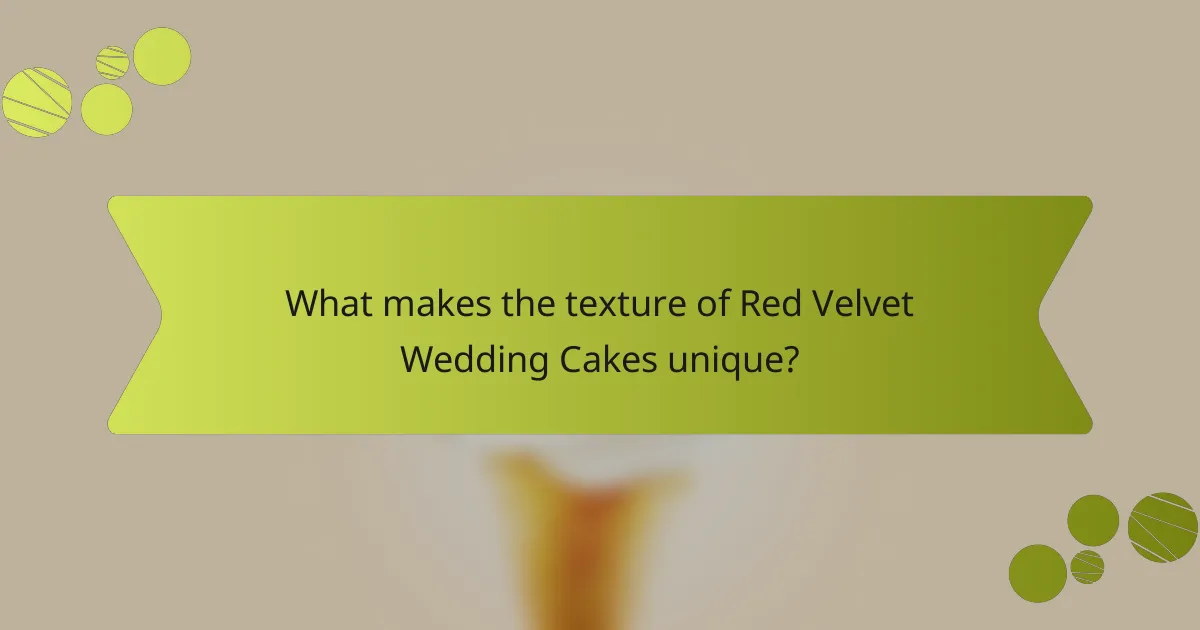
What makes the texture of Red Velvet Wedding Cakes unique?
The texture of Red Velvet Wedding Cakes is unique due to its combination of moistness and tenderness. This distinctive texture results from the use of buttermilk and oil in the batter. These ingredients contribute to a rich, velvety mouthfeel. The cake’s unique acidity from vinegar also enhances its softness. Additionally, the finely sifted cocoa powder adds a subtle density without being heavy. The cake is typically layered with cream cheese frosting, which complements its soft texture. This combination creates a luxurious eating experience that is both light and rich.
How does the choice of ingredients affect the texture?
The choice of ingredients significantly affects the texture of red velvet wedding cakes. Different ingredients contribute unique qualities to the cake’s mouthfeel and structure. For instance, the use of buttermilk creates a tender crumb due to its acidity, which activates baking soda. This reaction leads to a lighter texture. Conversely, using oil instead of butter results in a moist cake because oil retains moisture better than solid fats. The flour type also plays a crucial role; cake flour yields a softer texture compared to all-purpose flour. Furthermore, the addition of cocoa powder adds a slight density, enhancing the cake’s overall structure. Each ingredient’s specific properties work together to create the desired texture in red velvet cakes.
What role does buttermilk play in achieving the desired texture?
Buttermilk contributes to a tender and moist texture in red velvet wedding cakes. Its acidity reacts with baking soda, creating a leavening effect. This reaction helps the cake rise and results in a light crumb. Buttermilk also adds richness and a slight tang, enhancing flavor. The fat content in buttermilk contributes to the overall moisture of the cake. This moisture is essential for preventing a dry texture. Additionally, buttermilk helps in achieving a fine, even crumb structure. The combination of these factors makes buttermilk a key ingredient in achieving the desired texture in red velvet cakes.
How does the use of cocoa powder impact the cake’s consistency?
The use of cocoa powder impacts the cake’s consistency by adding moisture and density. Cocoa powder contributes to a richer texture in cakes. It can make the cake denser than cakes without cocoa. The fat content in cocoa powder also affects the overall moisture level. Higher moisture levels lead to a softer crumb. Additionally, cocoa powder can enhance the cake’s structure. This results in a more stable cake during baking. The combination of these factors creates a desirable mouthfeel in red velvet cakes.
What baking techniques enhance the texture of Red Velvet Cakes?
To enhance the texture of Red Velvet Cakes, specific baking techniques should be employed. Utilizing the creaming method is essential. This technique incorporates air into the butter and sugar mixture, resulting in a light and fluffy texture. Another effective method is the use of buttermilk. Buttermilk contributes to a tender crumb due to its acidity, which helps to break down gluten. Additionally, incorporating cake flour instead of all-purpose flour improves the cake’s softness. The use of vinegar and baking soda creates a chemical reaction that adds moisture and lightness. Finally, baking at the correct temperature ensures even cooking, preventing a dry texture. These techniques collectively create the desired moist and velvety texture characteristic of Red Velvet Cakes.
How does the mixing method influence the final texture?
The mixing method significantly influences the final texture of red velvet wedding cakes. Different mixing techniques incorporate varying amounts of air into the batter. For example, the creaming method incorporates butter and sugar first, creating a lighter texture. Conversely, the muffin method blends wet and dry ingredients without overmixing, resulting in a denser cake. The duration of mixing also affects gluten development. Longer mixing times can lead to a tougher texture due to increased gluten formation. In contrast, gentle mixing helps maintain a tender crumb. Studies show that the mixing method directly correlates with the cake’s final moisture content and mouthfeel. Thus, selecting the appropriate mixing method is crucial for achieving the desired texture in red velvet wedding cakes.
What is the significance of proper baking time and temperature?
Proper baking time and temperature are crucial for achieving the desired texture and flavor in red velvet wedding cakes. Baking at the correct temperature ensures even heat distribution, which prevents undercooking or overcooking. Undercooked cakes can result in a soggy texture, while overcooked cakes can become dry.
The typical baking temperature for red velvet cakes is around 350°F (175°C). This temperature allows the cake to rise properly and develop a soft crumb. The recommended baking time usually ranges from 25 to 30 minutes, depending on the cake’s size and thickness.
Using an oven thermometer can verify the accuracy of the baking temperature. Research shows that baking at the right temperature improves the Maillard reaction, enhancing flavor and color. Thus, proper baking time and temperature directly impact the cake’s overall quality and presentation.
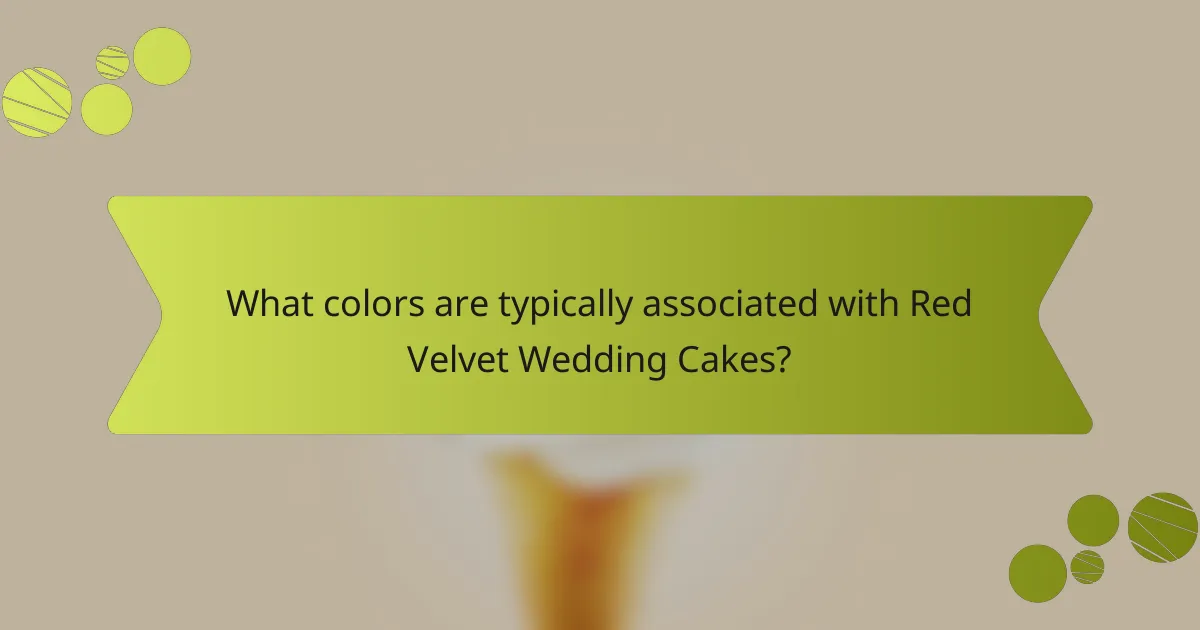
What colors are typically associated with Red Velvet Wedding Cakes?
Red velvet wedding cakes are typically associated with deep red, cream, and white colors. The deep red hue is the signature color of the cake, created by cocoa powder and red food coloring. Cream cheese frosting is commonly used, adding a creamy white contrast. White decorations, such as flowers or lace, often complement the cake. These colors create a classic and elegant appearance. The combination of red and white is visually striking, making it popular for weddings.
How is the iconic red color achieved in Red Velvet Cakes?
The iconic red color in Red Velvet Cakes is achieved through the use of cocoa powder and red food coloring. Natural cocoa powder contains anthocyanins, which can react with acidic ingredients like buttermilk and vinegar. This reaction can create a reddish hue. However, the addition of red food coloring enhances the color significantly. Typically, a combination of both cocoa powder and food coloring is used to achieve the desired vibrant red shade. This method has been popularized since the early 20th century, particularly in the Southern United States.
What natural ingredients can be used to create the red hue?
Beetroot powder, pomegranate juice, and hibiscus powder can create a red hue. Beetroot powder is derived from the root of the beet plant. It provides a vibrant red color due to its high betalain content. Pomegranate juice offers a natural red tint, rich in antioxidants. Hibiscus powder is made from dried hibiscus flowers. It imparts a deep red shade and has a tart flavor. These ingredients are often used in baking for their color and health benefits.
How do food colorings affect the final appearance?
Food colorings significantly influence the final appearance of red velvet wedding cakes. They enhance the cake’s visual appeal by providing vibrant colors. The specific type of food coloring used can affect the shade and intensity of the red hue. Natural colorings, like beet juice, yield a softer color compared to synthetic dyes, which provide a more vivid red. Additionally, the amount of food coloring incorporated can alter the cake’s overall look. Too little coloring may result in a pale appearance, while excessive amounts can lead to an unnatural look. The interaction of food colorings with other ingredients, such as cocoa powder, can also affect the final color outcome. For example, the acidity in buttermilk can intensify the red color when combined with certain food colorings.
What color combinations complement Red Velvet Wedding Cakes?
White and gold are color combinations that complement red velvet wedding cakes. The rich red color of the cake pairs beautifully with the elegance of white frosting. Gold accents add a luxurious touch to the overall presentation. Other effective combinations include cream and blush pink. These softer hues create a romantic atmosphere. Dark green foliage can also enhance the cake’s visual appeal. This combination provides a natural contrast to the vibrant red. Each of these color pairings enhances the aesthetic of red velvet wedding cakes.
What frosting colors pair well with Red Velvet Cake?
Cream cheese frosting is a classic pairing for Red Velvet Cake. Its tangy flavor complements the cake’s sweetness. White buttercream is another popular option. It provides a clean contrast to the red color. Additionally, chocolate ganache can enhance the cake’s richness. Pink or light pastel colors can also work well. These hues create a soft, romantic look. The combination of these frostings and Red Velvet Cake is visually appealing and delicious.
How do decorations enhance the overall color scheme?
Decorations enhance the overall color scheme by complementing or contrasting the primary colors. They add depth and visual interest to the design. For example, white icing on a red velvet cake creates a striking contrast. This contrast can highlight the cake’s rich red hue. Additionally, decorations like edible flowers or colored sprinkles can introduce new colors. These elements can harmonize with the existing palette or provide a pop of color. The careful selection of decorations ensures that the cake is visually appealing. A well-coordinated color scheme can elevate the cake’s presentation at a wedding.
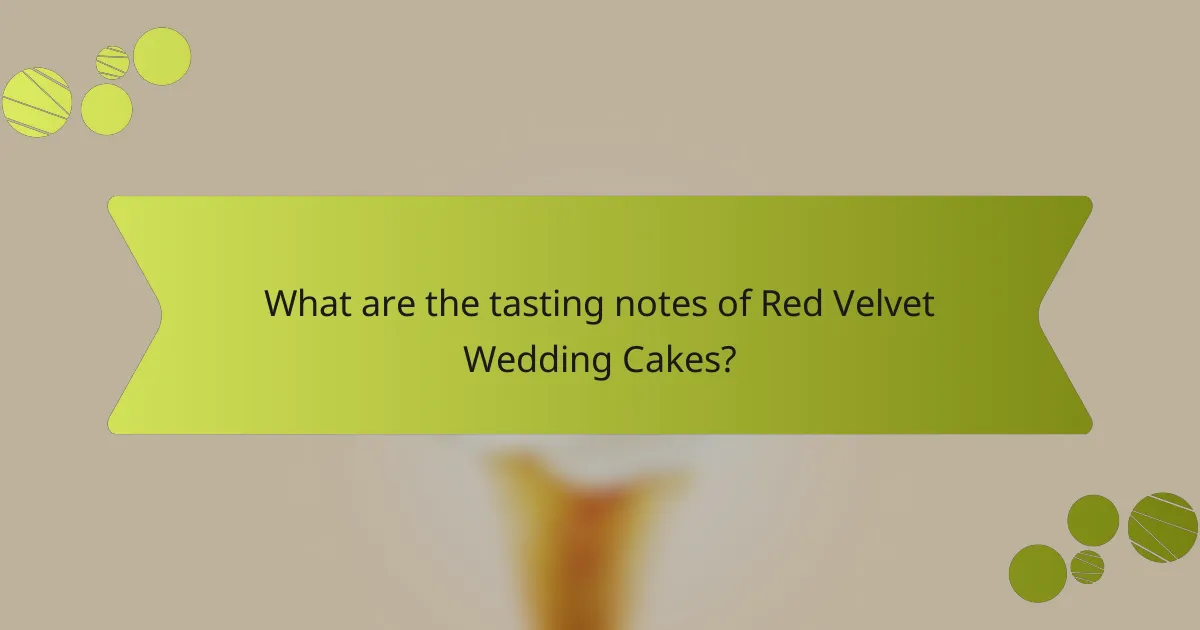
What are the tasting notes of Red Velvet Wedding Cakes?
Red Velvet Wedding Cakes have a rich, buttery flavor with subtle cocoa undertones. The cake is characterized by its moist, velvety texture, which contributes to its luxurious mouthfeel. The cream cheese or buttercream frosting adds a tangy sweetness that balances the cake’s richness. Additionally, the cake often has hints of vanilla, enhancing its overall flavor profile. The combination of these elements creates a unique and memorable tasting experience.
What flavor profile can one expect from a Red Velvet Cake?
Red Velvet Cake has a unique flavor profile characterized by a subtle chocolate taste combined with a hint of vanilla. The cake is often described as mildly sweet. Its flavor is enhanced by the addition of buttermilk, which adds a slight tanginess. The cake’s texture is moist and tender, contributing to the overall experience. The cream cheese frosting typically used adds a rich, creamy flavor that complements the cake. This combination creates a balanced taste that is both rich and refreshing. The red color, derived from cocoa and red food coloring, does not significantly alter the flavor but enhances visual appeal.
How do the ingredients contribute to the overall flavor?
Ingredients in red velvet wedding cakes significantly shape their overall flavor. Cocoa powder adds a subtle chocolate taste, enhancing richness. Buttermilk contributes tanginess, balancing sweetness and providing moisture. Vanilla extract introduces warmth and depth, rounding out the flavor profile. The cream cheese frosting adds a creamy, slightly tangy element that complements the cake’s sweetness. Each ingredient works synergistically to create a unique, layered flavor experience. This combination results in a dessert that is not only visually appealing but also deliciously complex.
What is the significance of cream cheese frosting in the taste experience?
Cream cheese frosting is significant in the taste experience of red velvet wedding cakes due to its unique flavor profile. It provides a tangy contrast to the sweetness of the cake. This balance enhances the overall taste experience. The creamy texture of the frosting adds richness, complementing the cake’s moistness. Additionally, the frosting’s slight acidity cuts through the richness of the cake. This interaction creates a more complex flavor profile. Cream cheese frosting is also popular for its ability to hold shape and form, making it visually appealing. Its versatility allows for various flavor infusions, further enriching the taste experience.
How can one enhance the tasting experience of Red Velvet Wedding Cakes?
To enhance the tasting experience of Red Velvet Wedding Cakes, consider pairing them with complementary flavors. Cream cheese frosting is a classic choice that balances the cake’s sweetness. Adding a hint of cocoa powder in the batter deepens the flavor profile. Incorporating vanilla extract can elevate the overall taste. Serving the cake with fresh berries adds a tart contrast. Pairing with a sweet dessert wine or champagne can also enhance the experience. These combinations create a more dynamic tasting experience.
What pairing suggestions exist for beverages with Red Velvet Cake?
Coffee, specifically espresso or a rich dark roast, pairs well with Red Velvet Cake. The bitterness of coffee complements the sweetness of the cake. Additionally, a glass of milk enhances the cake’s creamy texture. The creaminess of the milk balances the cake’s flavors. Red wine, particularly a light-bodied variety like Pinot Noir, also works. The fruity notes of the wine complement the cake’s chocolate undertones. Finally, a sweet dessert wine, such as Moscato, can enhance the overall experience. These pairings enhance the flavors and provide a harmonious tasting experience.
How can serving temperature affect the tasting notes?
Serving temperature significantly influences the tasting notes of red velvet wedding cakes. When served cold, the flavors may be muted and less pronounced. This can lead to a less enjoyable experience for the taster. Conversely, serving the cake at room temperature enhances the flavor profile. Warmer temperatures allow the cake’s buttery notes and chocolate undertones to emerge more fully. Studies show that temperature affects our perception of sweetness and richness. For example, a cake served at 68°F (20°C) may taste sweeter than the same cake at 32°F (0°C). Therefore, the optimal serving temperature can elevate the overall tasting experience.
What tips should one consider when choosing a Red Velvet Wedding Cake?
When choosing a Red Velvet Wedding Cake, consider flavor, texture, and color. The cake should have a rich cocoa flavor balanced with a hint of vanilla. Texture is crucial; it should be moist and velvety, not dry or crumbly. The color should be a vibrant red, achieved naturally or through food coloring. Evaluate the frosting; cream cheese frosting is traditional and complements the cake well. Consider the cake’s size based on guest count; a standard serving is one slice per guest. Lastly, taste samples from different bakers to ensure quality and personal preference.
Red Velvet Wedding Cakes are characterized by their distinctive red color, moist texture, and subtle chocolate flavor, often layered with cream cheese or buttercream frosting. The article explores the cake’s historical significance, its evolution in recipes, and the key characteristics that make it a popular choice for weddings. It also delves into the impact of ingredients on texture and flavor, color variations, and the importance of proper baking techniques. Additionally, the article provides insights into tasting notes, pairing suggestions, and tips for selecting the ideal Red Velvet Wedding Cake for special occasions.
